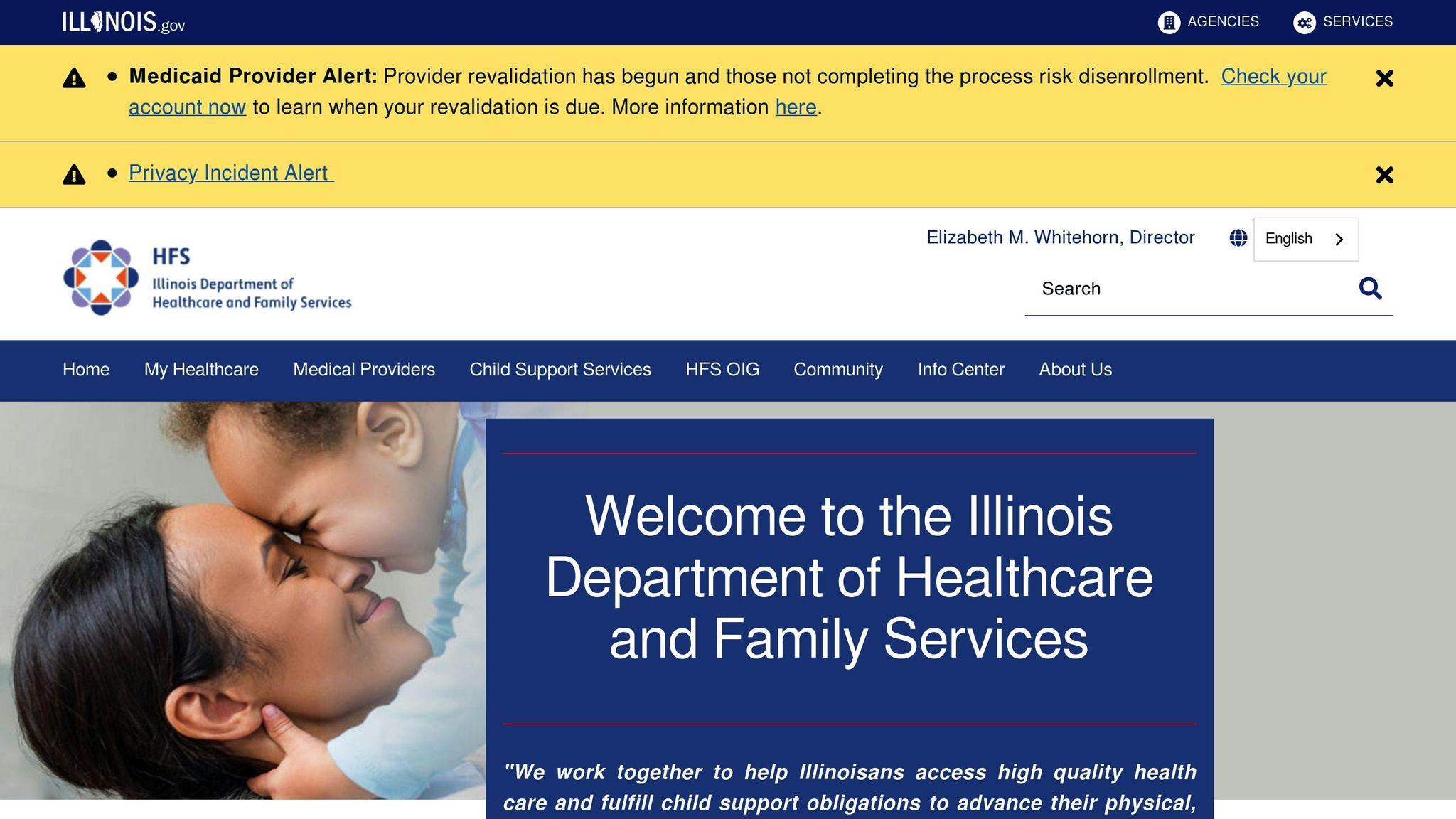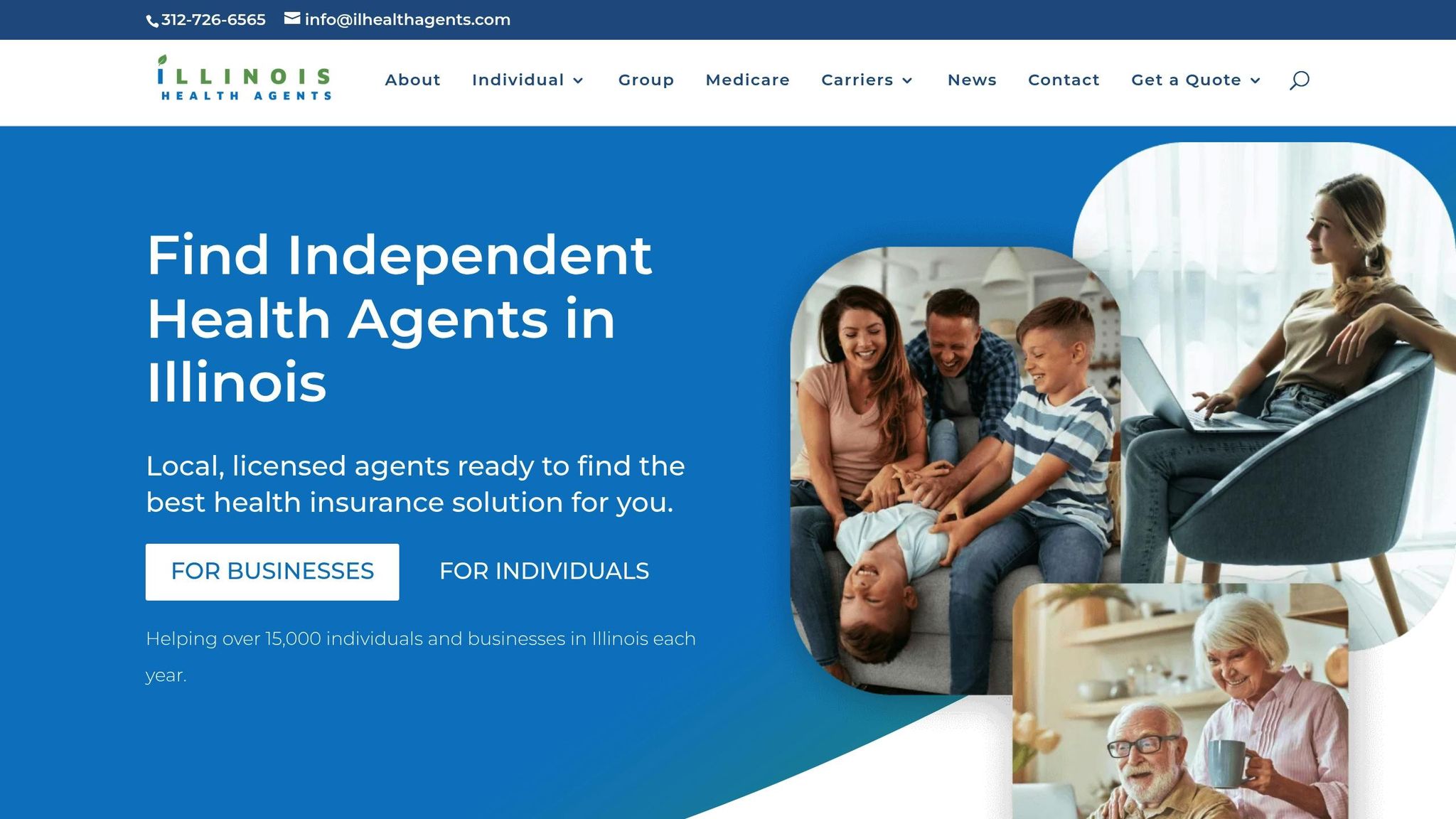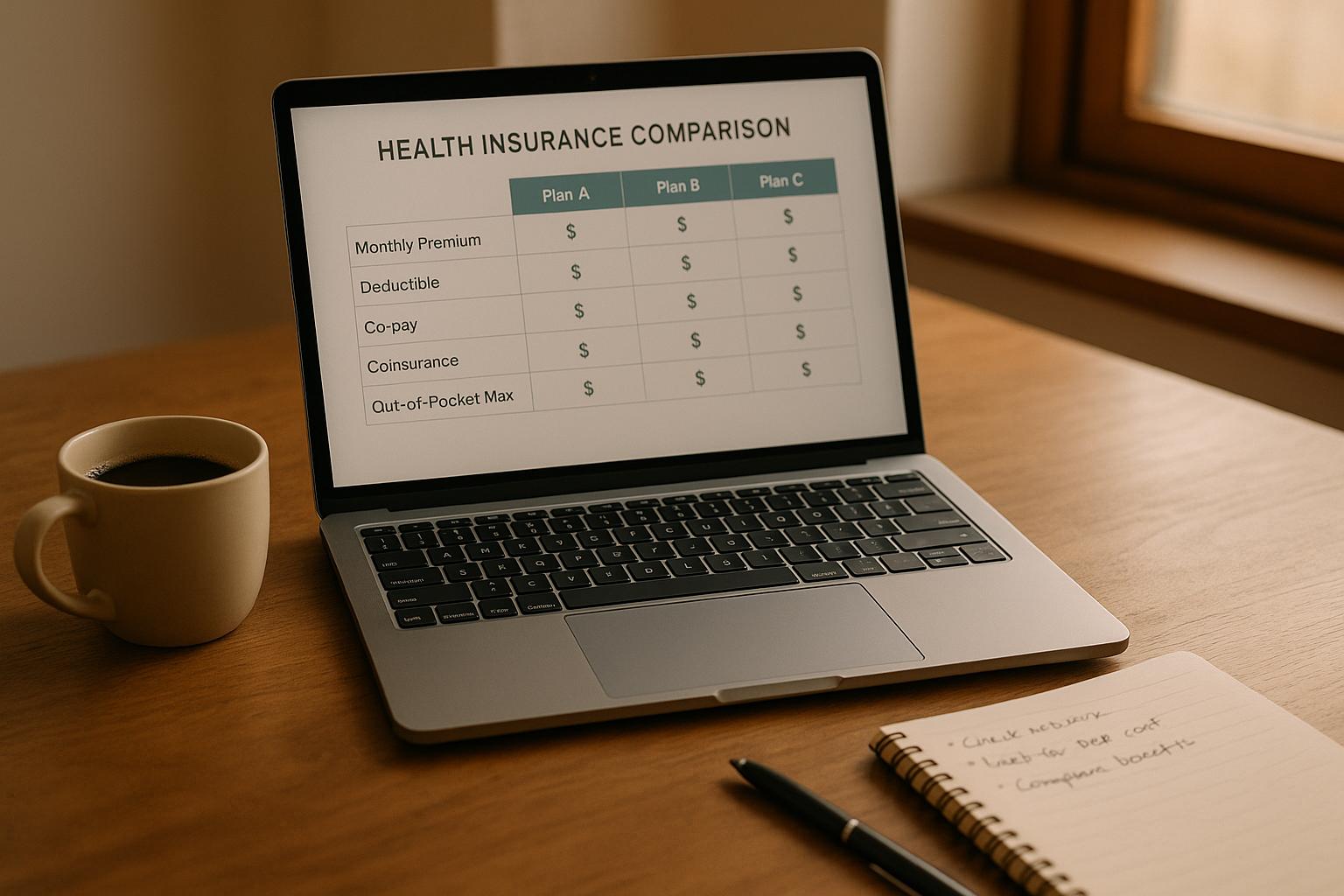When you’re self-employed, choosing the right health insurance can feel overwhelming. Here’s what matters most:
- Cost Breakdown: Don’t just focus on monthly premiums. Consider deductibles, copayments, coinsurance, and out-of-pocket maximums.
- Plan Types: ACA Marketplace plans (Bronze, Silver, Gold, Platinum) offer essential benefits and potential subsidies. Private insurance offers flexibility but may cost more. Short-term plans are cheaper but lack comprehensive coverage.
- Coverage Needs: Check for required benefits like preventive care, prescription drugs, and provider networks. Ensure your preferred doctors and medications are included.
- Subsidies: If your income qualifies, tax credits or Medicaid can lower costs significantly. In Illinois, resources like Get Covered Illinois can help.
- Plan Comparison: Create a table comparing costs, coverage, and networks to find the best fit for your needs and budget.
Quick Tip: ACA plans often balance affordability and coverage, especially with income-based subsidies. If you’re unsure, local agents or state programs can guide you.
Types of Health Insurance Costs & How to Compare Them
Health Insurance Plan Types for Self-Employed Individuals
When you’re self-employed, choosing the right health insurance plan can feel overwhelming. With so many options, each varying in cost and coverage, it’s essential to understand the details to find a plan that aligns with your health needs and budget.
ACA Marketplace Plans and Private Insurance
For self-employed individuals, ACA Marketplace plans are a popular choice because they offer broad coverage. These plans include the ten essential health benefits and come in four tiers: Bronze, Silver, Gold, and Platinum.
- Bronze plans: Lower monthly premiums but higher deductibles, typically ranging from $6,000 to $8,000 annually.
- Silver plans: Moderate premiums and deductibles, with deductibles usually around $3,000 to $5,000.
- Gold and Platinum plans: Higher premiums but significantly lower out-of-pocket costs, ideal for those with frequent medical needs.
One of the biggest advantages of ACA plans is the potential for subsidies. If your income is between 100% and 400% of the Federal Poverty Level (roughly $15,060 to $60,240 for an individual in 2025), you might qualify for premium tax credits to lower your monthly costs.
On the other hand, private insurance offers more flexibility in plan design but often comes at a higher price. Unlike ACA plans, private insurance may not include all essential benefits and does not qualify for subsidies, making it a less cost-effective option for many.
Next, let’s explore temporary coverage options and government-sponsored programs.
Short-Term Plans and Medicaid Options
If you need temporary coverage, short-term health insurance might be worth considering. These plans are more affordable, with premiums that are 50%–80% lower than ACA plans. However, they come with significant limitations: they don’t cover pre-existing conditions or essential benefits like maternity care or prescription drugs, and coverage typically lasts up to 12 months. These plans are best suited for healthy individuals needing short-term protection during life transitions. They’re not a good fit for anyone with ongoing or chronic health needs.
For those with lower incomes, Illinois Medicaid offers free or low-cost insurance. To qualify, your income must be at or below 138% of the Federal Poverty Level (about $20,783 for an individual in 2025). If you’re self-employed, eligibility is determined based on your net business income after deductions. Medicaid includes essential health benefits and minimal out-of-pocket costs, though the provider network may be more limited compared to ACA plans.
Additionally, Illinois provides special programs for specific situations. For example, continuation coverage allows you to extend a previous employer’s health insurance for up to 18 months, though you’ll pay the full premium plus administrative fees.
Key Cost Factors to Evaluate
When it comes to health insurance, the true cost goes far beyond just the monthly premium. If you’re self-employed, it’s important to take a closer look at all the components that make up your healthcare expenses. Understanding how these elements work together will give you a clearer picture of your overall financial responsibility.
Monthly Premiums, Deductibles, and Copayments
The monthly premium is the fixed amount you pay every month to keep your insurance active, regardless of whether you use any services. Once you’ve paid your premium, you’ll encounter other costs like the deductible, which is the amount you must pay out-of-pocket before your insurance starts covering a portion of your expenses. After meeting your deductible, you’ll then share costs through copayments (a fixed fee for services) and coinsurance (a percentage of the service cost).
The way these costs are structured can vary significantly between plans. For instance, plans with lower premiums often come with higher deductibles and copayments, meaning you’ll pay more out-of-pocket when you need care. On the other hand, plans with higher premiums may reduce these additional costs, which could be beneficial if you anticipate frequent healthcare needs.
Out-of-Pocket Maximums
Another critical factor to consider is the out-of-pocket maximum. This is the upper limit on how much you’ll spend in a plan year for covered in-network services. Once you hit this cap, your insurance takes over and pays 100% of your covered in-network costs for the rest of the year.
This limit offers a layer of financial protection, especially in cases of unexpected medical emergencies or serious illnesses. However, it’s essential to understand which expenses count toward this maximum. For example, costs like premiums or out-of-network services typically don’t apply to the cap.
When comparing plans, think about how the cost structure aligns with your healthcare needs. A plan with a lower out-of-pocket maximum might seem attractive, but if it comes with high copayments or coinsurance, your total expenses could still add up quickly. Additionally, if you frequently use out-of-network services, remember that those costs won’t contribute toward your maximum, which could impact your overall cost management.
How to Compare Coverage and Benefits
When choosing a health insurance plan, it’s not just about the price tag. The depth of coverage and the benefits offered are equally important, especially for self-employed individuals who need reliable protection against unexpected financial challenges.
Required Health Benefits
Making sure your plan covers the care you need is essential. As someone who’s self-employed, take the time to understand what services are included and how easily you can access them within your plan’s network.
All health insurance plans that comply with the Affordable Care Act (ACA) are required to cover ten essential health benefits. These include services like preventive care, emergency services, prescription drugs, maternity care, mental health support, and rehabilitative services. However, the way these benefits are delivered can differ between plans.
Preventive care is a standout benefit – it’s covered at 100%. That means you won’t pay out of pocket for annual checkups, vaccinations, or screenings like mammograms and colonoscopies. This not only saves money but also helps catch potential health issues early, when they’re typically easier and less expensive to treat.
Prescription drug coverage is another critical area to review. Each insurer provides a formulary, or a list of covered medications, categorized into tiers. Generic drugs are usually in the lowest-cost tier, while brand-name and specialty medications may come with higher copayments or coinsurance. If you depend on specific medications, check whether they’re included in the plan and at what cost level.
Once you’ve reviewed these basics, it’s time to look at provider networks and any extra benefits that could impact your overall experience.
Provider Networks and Extra Benefits
After considering costs, shift your focus to the accessibility of care and any added perks your plan might offer. Provider networks play a big role here. In-network providers have agreements with your insurance company to offer services at discounted rates, while out-of-network providers do not – often resulting in much higher out-of-pocket expenses.
To confirm whether a provider is in-network, reach out to your insurance company directly using the customer service number on your insurance card or explore their website. Many insurers also offer online tools or mobile apps to help you locate in-network providers in your area.
It’s important to note that just because a provider accepts your insurance doesn’t mean they’re part of your specific plan’s network. When contacting healthcare providers, be specific – ask if they participate in your exact plan to avoid any costly surprises.
"A referral from your doctor doesn’t necessarily mean your health insurance plan will cover the new provider." – HealthPartners
Always double-check that referrals are for in-network providers to steer clear of unexpected bills.
Different types of health plans offer varying levels of network flexibility. For instance, HMO plans usually require you to select a primary care physician and get referrals to see specialists. PPO plans, on the other hand, allow you to visit any provider, though you’ll pay less for in-network care. EPO plans strike a balance, offering some flexibility without requiring referrals, but they typically won’t cover out-of-network care unless it’s an emergency.
In addition to the required benefits, many plans include extras like vision and dental coverage, enhanced mental health services, telehealth options, wellness programs, or even discounts on gym memberships. While these perks shouldn’t be the sole reason for choosing a plan, they can be a nice bonus if they align with your needs.
Keep in mind that provider networks aren’t static. Changes like clinics closing, doctors relocating, or contract updates can affect network availability. It’s wise to review your network status annually during plan renewal or before visiting a new provider to avoid any unpleasant surprises.
sbb-itb-a729c26
Step-by-Step Plan Comparison Process
Now that you have a grasp of the key factors to evaluate, it’s time to put that knowledge to work. Taking a methodical approach to comparing health insurance plans can help you make a well-informed decision that aligns with your healthcare needs and budget.
Gather Your Information and Identify Your Needs
Before jumping into comparisons, set yourself up for success by gathering all the necessary information and analyzing your healthcare priorities. A little preparation can make the entire process smoother and more focused.
Start by collecting your financial details. Use your most recent tax returns to calculate your monthly income – this will give you a clear picture of what you can afford.
Then, make a list of your current medications and health conditions, including dosages and any ongoing treatments that require regular attention. If you have preferred doctors or specialists, jot down their names and contact information. This will help you check if they’re included in the networks of the plans you’re considering.
Think about your healthcare needs for the upcoming year. Are you planning to expand your family? Do you anticipate needing surgery or other major medical procedures? Perhaps you’re due for routine screenings or check-ups. While you can’t predict every scenario, having a general idea of your future needs will help you choose a plan that fits.
If you’re looking for family coverage, don’t forget to include the healthcare needs of each family member.
Finally, determine your budget parameters. Decide how much you’re comfortable spending on monthly premiums and consider how you’d handle unexpected medical expenses. Keep in mind that plans with lower premiums often come with higher out-of-pocket costs, so it’s crucial to strike a balance that works for you.
Once you’ve gathered all this information, you’re ready to move on to the next step.
Create a Comparison Table
Organizing your findings in a table can make it easier to evaluate your options side by side. This visual approach allows you to quickly identify differences and pinpoint which plan offers the best combination of cost and coverage for your situation.
Start by listing the plans you’re considering in separate columns, then add rows for the key features you want to compare. Be sure to include:
- Cost details: Monthly premiums, annual deductibles, and out-of-pocket maximums.
- Copayments: Amounts for primary care visits, specialist appointments, and emergency room services.
- Prescription coverage: Information on drug tiers and associated costs, especially if you rely on medication.
- Family coverage specifics: Include details on maternity care, pediatric services, or anything else relevant to your household.
- Plan type: Note whether it’s an HMO, PPO, or EPO, as this impacts how you’ll access care.
- Provider network: Check if your preferred doctors, specialists, or hospitals are included.
By filling in these details, you’ll create a clear snapshot of each plan’s strengths and weaknesses, helping you make a more informed choice.
Check for Subsidies and Financial Help
Once you’ve outlined your financial situation, don’t forget to explore potential savings through subsidies or financial assistance. These can make a bigger difference than you might expect, especially when it comes to reducing overall costs.
Start by checking your eligibility for premium tax credits and cost-sharing reductions offered through ACA marketplace plans. Use your most recent tax return to estimate your annual income, as this will determine your subsidy eligibility. Keep in mind that any significant difference between your estimated and actual income could affect the amount of financial help you receive when tax season rolls around.
Additionally, some states offer extra assistance through expanded Medicaid or state-specific health programs. These options are typically available only if you enroll in a marketplace plan, so be sure to factor them into your decision-making process.
Illinois-Specific Factors for Self-Employed Individuals
If you’re self-employed in Illinois, you have access to state resources and local expertise that can help lower your insurance costs. These Illinois-specific options work alongside the general steps for comparing plan costs and benefits, giving you additional tools to find coverage that fits your needs.
Illinois Medicaid and State Rules

Illinois offers expanded Medicaid, including a group called "ACA Adults", designed for self-employed individuals aged 19–64 without dependents. This program provides free or low-cost health coverage to those who qualify.
Eligibility for Medicaid in Illinois is determined using all sources of income. The application process is streamlined, allowing you to check your eligibility for both Medicaid and marketplace financial assistance with a single form. To begin, visit www.GetCoveredIllinois.gov or call the Marketplace Help Desk at 1-866-311-1119.
If you don’t meet the Medicaid criteria, you may still qualify for financial assistance through the Health Insurance Marketplace. These savings are based on your estimated annual income, which can be tricky to calculate if your income fluctuates. Be sure to update your application if your earnings change during the year – this ensures your coverage and savings are adjusted appropriately. However, keep in mind that if someone claims you as a tax dependent, you won’t be eligible for income-based savings on marketplace plans.
Working with Illinois Health Agents

In addition to state programs, local health insurance agents offer valuable support. These agents simplify the process of comparing plans and finding cost-effective options. Their services are free to you because they’re compensated directly by insurance companies.
Local agents bring a wealth of knowledge, helping you compare plans from both the ACA Health Insurance Marketplace and private insurers. As Patrick McKeegan, a small business owner, advises:
"Find an independent agent that represents all of the policies available. There will be no charge to you, they get paid by the insurance companies when you sign up. A good agent will discuss how you plan on using your insurance and recommend a policy that fits your needs."
Illinois Health Agents specialize in working with self-employed individuals across the state. They provide access to a variety of insurance options, including ACA plans, short-term coverage, and supplemental policies like vision and dental. Their familiarity with Illinois-specific regulations and programs means they can uncover subsidies and solutions you might overlook on your own.
In addition to independent agents, certified assisters through programs like Get Covered Illinois also provide local guidance. When consulting with an agent or broker, make sure to discuss your healthcare usage, ongoing medical needs, preferred providers, and budget. This information will help them recommend a policy that aligns with your unique circumstances.
Key Points for Comparing Health Insurance Costs
When comparing health insurance costs, it’s important to look at the full financial picture, not just the monthly premium. This means considering premiums, deductibles, copayments, coinsurance, and out-of-pocket maximums. For example, national averages show that individual deductibles typically hover around $4,394, while family deductibles can climb to $7,800. Additionally, the type of plan you choose and its metal tier can greatly influence your overall cost structure.
Metal tiers help break down cost-sharing arrangements. Bronze plans, for instance, have lower premiums but higher out-of-pocket costs when you use medical services. On the other end, Platinum plans come with higher premiums but lower costs for care. Silver plans often strike a balance and may be the best fit for self-employed individuals who qualify for cost-sharing reductions through the marketplace.
The type of plan you select also impacts both your expenses and your flexibility. Health Maintenance Organizations (HMOs) generally have lower premiums but require you to stick to in-network providers and get referrals for specialists. Preferred Provider Organizations (PPOs), while more expensive, offer greater flexibility, including the ability to see out-of-network doctors. Your choice should depend on whether you value lower costs or greater provider options.
Financial assistance can significantly lower your costs. Programs like premium tax credits and cost-sharing reductions, available through the Health Insurance Marketplace, are based on your income and household size. These options can make higher-tier plans more affordable and should be factored into your decision.
It’s also worth thinking beyond immediate costs to consider how your plan affects your long-term finances. For instance, you can deduct 100% of your health insurance premiums from your taxable income, reducing the amount of income you’re taxed on. This deduction applies whether you itemize or take the standard deduction.
When picking a plan, align it with your health needs. If you frequently visit specialists or take prescription medications, a plan with higher premiums but lower copayments might save you money in the long run. Think about your current health, medical history, and expected healthcare usage when making your choice.
Don’t forget that demographic factors also play a big role in determining premiums. Your age, tobacco use, ZIP code, and the number of dependents you’re covering all influence your costs. Family coverage, for example, is significantly more expensive than individual plans.
Finally, all Affordable Care Act (ACA) plans include essential health benefits, ensuring that you’re protected from coverage gaps. This standardization means you can focus on comparing costs without worrying about whether basic services are covered.
FAQs
What should I look at besides monthly premiums when comparing health insurance plans?
When evaluating health insurance plans, don’t just focus on the monthly premium. It’s equally important to factor in deductibles, copayments, coinsurance, and the out-of-pocket maximum – these elements determine how much you’ll actually spend on healthcare over the course of the year.
Take a close look at the plan’s coverage benefits to confirm it includes the services you rely on, whether that’s preventive care, visits to specialists, or mental health support. Make sure to check the provider network to see if your preferred doctors and hospitals are included. Additionally, review the prescription drug coverage to ensure your medications are part of the plan. Lastly, understand the plan type – whether it’s an HMO or PPO – and decide if it matches your needs for flexibility and whether referrals are required.
Am I eligible for subsidies or financial assistance for health insurance as a self-employed individual?
As someone who is self-employed, you might qualify for financial assistance or subsidies if your household income falls between 100% and 400% of the federal poverty level (FPL). Your eligibility could also depend on whether your state has chosen to expand Medicaid. To figure this out, take a look at your income, household size, and whether Medicaid expansion applies in your state. Tools like federal income guidelines or tax credit calculators can be helpful in estimating your eligibility.
Subsidies are specifically designed to make health insurance more affordable, so it’s worth checking even if you’re unsure. If you need more tailored help, reaching out to a licensed health insurance broker can be a great way to get step-by-step guidance through the process.
What’s the difference between ACA Marketplace plans and private health insurance for self-employed individuals?
ACA Marketplace plans are built to offer budget-friendly health coverage and often come with income-based subsidies to help lower costs. These plans are required to meet federal guidelines for benefits and are available through state or federal exchanges. This means they provide a consistent level of coverage and a clear understanding of what’s included.
In contrast, private health insurance is purchased directly from insurance providers and usually offers a broader range of plan options. While these plans may allow for more customized coverage, they typically don’t include subsidies, which can result in higher premiums. Private plans might be a great choice if you’re looking for specific benefits, but they often come with fewer consumer protections compared to ACA Marketplace options.



0 Comments